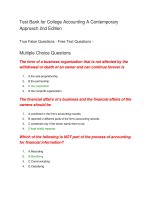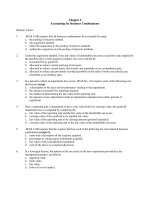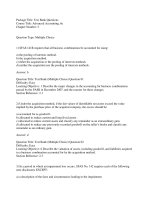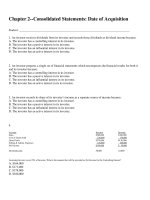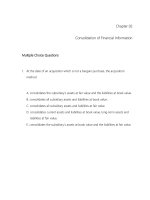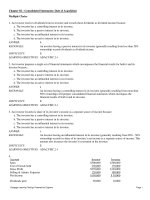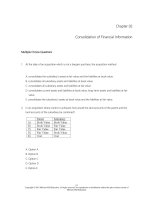College accounting chapters 1 15 22nd edition heintz test bank
Bạn đang xem bản rút gọn của tài liệu. Xem và tải ngay bản đầy đủ của tài liệu tại đây (1.3 MB, 47 trang )
Chapter_2_Analyzing_Transactions_The_Accounting_Equation.pdf
HP22e_AT_Test_A_Ch01&02_Sol_Final.pdf
HP22e_AT_Test_A_Ch01&02_Student_Final.pdf
HP22e_AT_Test_B_Ch01&02_Sol_Final.pdf
HP22e_AT_Test_B_Ch01&02_Student_Final.pdf
Chapter 2—Analyzing Transactions: The Accounting Equation
1. A business entity is an individual, association, or organization with control over economic resources and which engages
in economic activities.
a. True
b. False
ANSWER:
True
POINTS:
1
DIFFICULTY:
Easy
LEARNING OBJECTIVES:
COLL.HEIN.17.1 - LO: 2-1
ACCREDITING STANDARDS: AICPA BB-Industry
BUSPROG: Communication
TOPICS:
ACBSP: APC-03-Business Forms
KEYWORDS:
Bloom's: Remembering
NOTES:
1 min.
2. Liabilities represent an "inside" interest in a business.
a. True
b. False
ANSWER:
False
POINTS:
1
DIFFICULTY:
Easy
LEARNING OBJECTIVES:
COLL.HEIN.17.1 - LO: 2-1
ACCREDITING STANDARDS: AICPA BB-Industry
BUSPROG: Communication
TOPICS:
ACBSP: APC-03-Business Forms
KEYWORDS:
Bloom's: Remembering
NOTES:
1 min.
3. The accounting equation shows the relationship among the three basic accounting elements—assets, expenses, and
owner's equity.
a. True
b. False
ANSWER:
False
POINTS:
1
DIFFICULTY:
Easy
LEARNING OBJECTIVES:
COLL.HEIN.17.2 - LO: 2-2
ACCREDITING STANDARDS: AICPA BB-Industry
BUSPROG: Communication
TOPICS:
ACBSP: APC-02-GAAP
KEYWORDS:
Bloom's: Remembering
NOTES:
1 min.
4. If owner's equity and liabilities increased during the period, then assets must also have increased.
a. True
b. False
ANSWER:
True
Cengage Learning Testing, Powered by Cognero
Page 1
Chapter 2—Analyzing Transactions: The Accounting Equation
POINTS:
DIFFICULTY:
LEARNING OBJECTIVES:
ACCREDITING STANDARDS:
TOPICS:
KEYWORDS:
NOTES:
1
Easy
COLL.HEIN.17.2 - LO: 2-2
AICPA BB-Industry
BUSPROG: Communication
ACBSP: APC-02-GAAP
Bloom's: Remembering
1 min.
5. An accounts payable is an unwritten promise to pay a supplier for assets purchased or services rendered.
a. True
b. False
ANSWER:
True
POINTS:
1
DIFFICULTY:
Easy
LEARNING OBJECTIVES:
COLL.HEIN.17.1 - LO: 2-1
ACCREDITING STANDARDS: AICPA BB-Industry
BUSPROG: Communication
TOPICS:
ACBSP: APC-02-GAAP
KEYWORDS:
Bloom's: Remembering
NOTES:
1 min.
6. If the revenue of a period exceeds the expenses, the excess represents a net loss.
a. True
b. False
ANSWER:
False
POINTS:
1
DIFFICULTY:
Easy
LEARNING OBJECTIVES:
COLL.HEIN.17.3 - LO: 2-5
ACCREDITING STANDARDS: AICPA BB-Industry
BUSPROG: Communication
TOPICS:
ACBSP: APC-09-Financial Statements
KEYWORDS:
Bloom's: Evaluating
NOTES:
1 min.
7. Any accounting period of twelve months' duration is usually referred to as a fiscal year.
a. True
b. False
ANSWER:
True
POINTS:
1
DIFFICULTY:
Easy
LEARNING OBJECTIVES:
COLL.HEIN.17.3 - LO: 2-5
ACCREDITING STANDARDS: AICPA BB-Industry
BUSPROG: Communication
TOPICS:
ACBSP: APC-02-GAAP
Cengage Learning Testing, Powered by Cognero
Page 2
Chapter 2—Analyzing Transactions: The Accounting Equation
KEYWORDS:
NOTES:
Bloom's: Remembering
1 min.
8. Revenues received during an accounting period increase owner's equity.
a. True
b. False
ANSWER:
True
POINTS:
1
DIFFICULTY:
Easy
LEARNING OBJECTIVES:
COLL.HEIN.17.4 - LO: 2-4
ACCREDITING STANDARDS: AICPA BB-Industry
BUSPROG: Communication
TOPICS:
ACBSP: APC-09-Financial Statements
KEYWORDS:
Bloom's: Remembering
NOTES:
1 min.
9. Since supplies last for several months, they are recorded as assets.
a. True
b. False
ANSWER:
True
POINTS:
1
DIFFICULTY:
Easy
LEARNING OBJECTIVES:
COLL.HEIN.17.4 - LO: 2-4
ACCREDITING STANDARDS: AICPA FN-Measurement
BUSPROG: Communication
TOPICS:
ACBSP: APC-02-GAAP
KEYWORDS:
Bloom's: Remembering
NOTES:
1 min.
10. Since insurance lasts for several months, it is recorded as owner's equity.
a. True
b. False
ANSWER:
False
POINTS:
1
DIFFICULTY:
Easy
LEARNING OBJECTIVES:
COLL.HEIN.17.4 - LO: 2-4
ACCREDITING STANDARDS: AICPA FN-Measurement
BUSPROG: Communication
TOPICS:
ACBSP: APC-02-GAAP
KEYWORDS:
Bloom's: Remembering
NOTES:
1 min.
11. The income statement provides information about events over a period of a month, year, or other period of time.
a. True
b. False
Cengage Learning Testing, Powered by Cognero
Page 3
Chapter 2—Analyzing Transactions: The Accounting Equation
ANSWER:
POINTS:
DIFFICULTY:
LEARNING OBJECTIVES:
ACCREDITING STANDARDS:
TOPICS:
KEYWORDS:
NOTES:
True
1
Easy
COLL.HEIN.17.3 - LO: 2-5
AICPA BB-Industry
BUSPROG: Communication
ACBSP: APC-09-Financial Statements
Bloom's: Remembering
1 min.
12. The terms "profit and loss statement" or "operating statement" are sometimes used as synonyms for the balance sheet.
a. True
b. False
ANSWER:
False
POINTS:
1
DIFFICULTY:
Easy
LEARNING OBJECTIVES:
COLL.HEIN.17.3 - LO: 2-5
ACCREDITING STANDARDS: AICPA BB-Industry
BUSPROG: Communication
TOPICS:
ACBSP: APC-09-Financial Statements
KEYWORDS:
Bloom's: Remembering
NOTES:
1 min.
13. Other terms used for owner's equity include net worth and capital.
a. True
b. False
ANSWER:
True
POINTS:
1
DIFFICULTY:
Easy
LEARNING OBJECTIVES:
COLL.HEIN.17.1 - LO: 2-1
ACCREDITING STANDARDS: AICPA BB-Industry
BUSPROG: Communication
TOPICS:
ACBSP: APC-02-GAAP
KEYWORDS:
Bloom's: Remembering
NOTES:
1 min.
14. Any item a business owns that will provide future benefits is called owner's equity.
a. True
b. False
ANSWER:
False
POINTS:
1
DIFFICULTY:
Easy
LEARNING OBJECTIVES:
COLL.HEIN.17.1 - LO: 2-1
ACCREDITING STANDARDS: AICPA BB-Industry
BUSPROG: Communication
Cengage Learning Testing, Powered by Cognero
Page 4
Chapter 2—Analyzing Transactions: The Accounting Equation
TOPICS:
KEYWORDS:
NOTES:
ACBSP: APC-02-GAAP
Bloom's: Remembering
1 min.
15. It is not necessary to measure a business transaction in dollars.
a. True
b. False
ANSWER:
False
POINTS:
1
DIFFICULTY:
Easy
LEARNING OBJECTIVES:
COLL.HEIN.17.5 - LO: 2-3
ACCREDITING STANDARDS: AICPA BB-Industry
BUSPROG: Communication
TOPICS:
ACBSP: APC-02-GAAP
KEYWORDS:
Bloom's: Remembering
NOTES:
1 min.
16. The accounting equation may be expressed as assets − liabilities = owner's equity.
a. True
b. False
ANSWER:
True
POINTS:
1
DIFFICULTY:
Easy
LEARNING OBJECTIVES:
COLL.HEIN.17.2 - LO: 2-2
ACCREDITING STANDARDS: AICPA BB-Industry
BUSPROG: Communication
TOPICS:
ACBSP: APC-02-GAAP
KEYWORDS:
Bloom's: Remembering
NOTES:
1 min.
17. According to the business entity concept, a proprietor may include nonbusiness assets and liabilities in the business
entity's accounting records.
a. True
b. False
ANSWER:
False
POINTS:
1
DIFFICULTY:
Easy
LEARNING OBJECTIVES:
COLL.HEIN.17.1 - LO: 2-1
ACCREDITING STANDARDS: AICPA BB-Industry
BUSPROG: Communication
TOPICS:
ACBSP: APC-02-GAAP
KEYWORDS:
Bloom's: Remembering
NOTES:
1 min.
18. Recognizing the effects of transactions on assets, liabilities, owner's equity, revenue, and expenses of a business is the
Cengage Learning Testing, Powered by Cognero
Page 5
Chapter 2—Analyzing Transactions: The Accounting Equation
processing function.
a. True
b. False
ANSWER:
POINTS:
DIFFICULTY:
LEARNING OBJECTIVES:
ACCREDITING STANDARDS:
TOPICS:
KEYWORDS:
NOTES:
True
1
Easy
COLL.HEIN.17.6 - LO: 2-6
AICPA FN-Measurement
BUSPROG: Communication
ACBSP: APC-06-Recording Transactions
Bloom's: Understanding
1 min.
19. Expenses represent a decrease in liabilities.
a. True
b. False
ANSWER:
False
POINTS:
1
DIFFICULTY:
Easy
LEARNING OBJECTIVES:
COLL.HEIN.17.4 - LO: 2-4
ACCREDITING STANDARDS: AICPA FN-Measurement
BUSPROG: Communication
TOPICS:
ACBSP: APC-02-GAAP
KEYWORDS:
Bloom's: Remembering
NOTES:
1 min.
20. Expenses that are incurred in operating the enterprise increase owner's equity.
a. True
b. False
ANSWER:
False
POINTS:
1
DIFFICULTY:
Easy
LEARNING OBJECTIVES:
COLL.HEIN.17.4 - LO: 2-4
ACCREDITING STANDARDS: AICPA FN-Measurement
BUSPROG: Communication
TOPICS:
ACBSP: APC-02-GAAP
KEYWORDS:
Bloom's: Understanding
NOTES:
1 min.
21. Withdrawing cash from a business entity will result in an increase in owner's equity.
a. True
b. False
ANSWER:
False
POINTS:
1
DIFFICULTY:
Easy
Cengage Learning Testing, Powered by Cognero
Page 6
Chapter 2—Analyzing Transactions: The Accounting Equation
LEARNING OBJECTIVES:
COLL.HEIN.17.4 - LO: 2-4
ACCREDITING STANDARDS: AICPA FN-Measurement
BUSPROG: Communication
TOPICS:
ACBSP: APC-02-GAAP
KEYWORDS:
Bloom's: Understanding
NOTES:
1 min.
22. An increase in a revenue account may also result in an increase in the accounts receivable account.
a. True
b. False
ANSWER:
True
POINTS:
1
DIFFICULTY:
Easy
LEARNING OBJECTIVES:
COLL.HEIN.17.4 - LO: 2-4
ACCREDITING STANDARDS: AICPA FN-Measurement
BUSPROG: Communication
TOPICS:
ACBSP: APC-09-Financial Statements
KEYWORDS:
Bloom's: Understanding
NOTES:
1 min.
23. Financial statements commonly prepared by businesses include an income statement, a statement of owner's equity,
and a balance sheet.
a. True
b. False
ANSWER:
True
POINTS:
1
DIFFICULTY:
Easy
LEARNING OBJECTIVES:
COLL.HEIN.17.3 - LO: 2-5
ACCREDITING STANDARDS: AICPA FN-Measurement
BUSPROG: Communication
TOPICS:
ACBSP: APC-09-Financial Statements
KEYWORDS:
Bloom's: Remembering
NOTES:
1 min.
24. The statement of owner's equity shows the state of the business on a specific date.
a. True
b. False
ANSWER:
False
POINTS:
1
DIFFICULTY:
Easy
LEARNING OBJECTIVES:
COLL.HEIN.17.3 - LO: 2-5
ACCREDITING STANDARDS: AICPA FN-Measurement
BUSPROG: Communication
TOPICS:
ACBSP: APC-09-Financial Statements
KEYWORDS:
Bloom's: Remembering
Cengage Learning Testing, Powered by Cognero
Page 7
Chapter 2—Analyzing Transactions: The Accounting Equation
NOTES:
1 min.
25. The balance sheet reports assets, liabilities, and owner's equity on a specific date.
a. True
b. False
ANSWER:
True
POINTS:
1
DIFFICULTY:
Easy
LEARNING OBJECTIVES:
COLL.HEIN.17.3 - LO: 2-5
ACCREDITING STANDARDS: AICPA FN-Measurement
BUSPROG: Communication
TOPICS:
ACBSP: APC-09-Financial Statements
KEYWORDS:
Bloom's: Remembering
NOTES:
1 min.
26. The income statement and statement of owner's equity provide information covering a period of time.
a. True
b. False
ANSWER:
True
POINTS:
1
DIFFICULTY:
Easy
LEARNING OBJECTIVES:
COLL.HEIN.17.3 - LO: 2-5
ACCREDITING STANDARDS: AICPA FN-Measurement
BUSPROG: Communication
TOPICS:
ACBSP: APC-09-Financial Statements
KEYWORDS:
Bloom's: Remembering
NOTES:
1 min.
27. The accounting equation may be expressed as
a. owner's equity = assets − liabilities.
b. revenue − expenses = net income.
c. revenue = net income − expenses.
d. liabilities − owner's equity = assets.
ANSWER:
a
POINTS:
1
DIFFICULTY:
Easy
LEARNING OBJECTIVES:
COLL.HEIN.17.2 - LO: 2-2
ACCREDITING STANDARDS: AICPA FN-Measurement
BUSPROG: Communication
TOPICS:
ACBSP: APC-02-GAAP
KEYWORDS:
Bloom's: Remembering
NOTES:
1 min.
28. Jason purchased office equipment for $4,800 in cash. This transaction would
a. increase assets and increase owner's equity.
Cengage Learning Testing, Powered by Cognero
Page 8
Chapter 2—Analyzing Transactions: The Accounting Equation
b. increase assets and increase liabilities.
c. increase one asset and decrease another asset.
d. decrease assets and decrease liabilities.
ANSWER:
c
POINTS:
1
DIFFICULTY:
Moderate
LEARNING OBJECTIVES:
COLL.HEIN.17.4 - LO: 2-4
ACCREDITING STANDARDS: AICPA FN-Measurement
BUSPROG: Analytic
TOPICS:
ACBSP: APC-02-GAAP
KEYWORDS:
Bloom's: Remembering
NOTES:
1 min.
29. Stephen purchased office supplies for $800 on account. This transaction would
a. increase assets and increase owner's equity.
b. increase one asset and decrease another asset.
c. increase assets and increase liabilities.
d. decrease assets and decrease liabilities.
ANSWER:
c
POINTS:
1
DIFFICULTY:
Moderate
LEARNING OBJECTIVES:
COLL.HEIN.17.4 - LO: 2-4
ACCREDITING STANDARDS: AICPA FN-Measurement
BUSPROG: Analytic
TOPICS:
ACBSP: APC-02-GAAP
KEYWORDS:
Bloom's: Remembering
NOTES:
1 min.
30. Meghan started her business by investing $30,000 in cash. This transaction would
a. increase assets and increase owner's equity.
b. increase assets and increase liabilities.
c. increase one asset and decrease another asset.
d. decrease assets and decrease liabilities.
ANSWER:
a
POINTS:
1
DIFFICULTY:
Moderate
LEARNING OBJECTIVES:
COLL.HEIN.17.4 - LO: 2-4
ACCREDITING STANDARDS: AICPA FN-Measurement
BUSPROG: Analytic
TOPICS:
ACBSP: APC-02-GAAP
KEYWORDS:
Bloom's: Remembering
NOTES:
1 min.
31. Any accounting period of twelve months' duration is usually referred to as a(n)
Cengage Learning Testing, Powered by Cognero
Page 9
Chapter 2—Analyzing Transactions: The Accounting Equation
a. fiscal year.
b. calendar year.
c. physical year.
d. operational year.
ANSWER:
POINTS:
DIFFICULTY:
LEARNING OBJECTIVES:
ACCREDITING STANDARDS:
TOPICS:
KEYWORDS:
NOTES:
a
1
Easy
COLL.HEIN.17.4 - LO: 2-4
AICPA BB-Industry
BUSPROG: Communication
ACBSP: APC-02-GAAP
Bloom's: Remembering
1 min.
32. Increases to owner's equity may be from
a. expenses that are incurred.
b. expenses exceeding revenue for the period.
c. withdrawals of cash from the business by the owner.
d. revenue that is derived from sales of goods or services.
ANSWER:
d
POINTS:
1
DIFFICULTY:
Easy
LEARNING OBJECTIVES:
COLL.HEIN.17.4 - LO: 2-4
ACCREDITING STANDARDS: AICPA BB-Critical thinking
BUSPROG: Communication
TOPICS:
ACBSP: APC-09-Financial Statements
KEYWORDS:
Bloom's: Understanding
NOTES:
1 min.
33. Tyler paid $3,700 on account to the company from which equipment was purchased on credit. This transaction would
a. decrease assets and decrease liabilities.
b. increase assets and increase owner's equity.
c. increase assets and increase liabilities.
d. increase one asset and decrease another asset.
ANSWER:
a
POINTS:
1
DIFFICULTY:
Moderate
LEARNING OBJECTIVES:
COLL.HEIN.17.4 - LO: 2-4
ACCREDITING STANDARDS: AICPA FN-Measurement
BUSPROG: Analytic
TOPICS:
ACBSP: APC-02-GAAP
KEYWORDS:
Bloom's: Remembering
NOTES:
1 min.
Cengage Learning Testing, Powered by Cognero
Page 10
Chapter 2—Analyzing Transactions: The Accounting Equation
34. An example of an expense is
a. investments.
b. supplies consumed.
c. prepaid insurance.
d. withdrawals by the owner.
ANSWER:
b
POINTS:
1
DIFFICULTY:
Easy
LEARNING OBJECTIVES:
COLL.HEIN.17.4 - LO: 2-4
ACCREDITING STANDARDS: AICPA FN-Measurement
BUSPROG: Communication
TOPICS:
ACBSP: APC-02-GAAP
KEYWORDS:
Bloom's: Remembering
NOTES:
1 min.
35. A decrease in owner's equity may result from a(n)
a. purchase of office supplies for cash.
b. withdrawal of cash from the business by the owner.
c. revenue that is derived from sales of goods or services.
d. investment of cash in the business by the owner.
ANSWER:
b
POINTS:
1
DIFFICULTY:
Easy
LEARNING OBJECTIVES:
COLL.HEIN.17.4 - LO: 2-4
ACCREDITING STANDARDS: AICPA BB-Critical thinking
BUSPROG: Analytic
TOPICS:
ACBSP: APC-09-Financial Statements
KEYWORDS:
Bloom's: Understanding
NOTES:
1 min.
36. Which phase of the accounting process involves recognizing the effect of transactions on assets, liabilities, owner's
equity, revenue, and expenses of a business?
a. input
b. processing
c. output
d. summarizing
ANSWER:
b
POINTS:
1
DIFFICULTY:
Easy
LEARNING OBJECTIVES:
COLL.HEIN.17.6 - LO: 2-6
ACCREDITING STANDARDS: AICPA BB-Industry
BUSPROG: Communication
TOPICS:
ACBSP: APC-06-Recording Transactions
KEYWORDS:
Bloom's: Remembering
Cengage Learning Testing, Powered by Cognero
Page 11
Chapter 2—Analyzing Transactions: The Accounting Equation
NOTES:
1 min.
37. The financial statement that should be completed first is the
a. balance sheet.
b. statement of financial position.
c. statement of financial condition.
d. income statement.
ANSWER:
d
POINTS:
1
DIFFICULTY:
Easy
LEARNING OBJECTIVES:
COLL.HEIN.17.3 - LO: 2-5
ACCREDITING STANDARDS: AICPA FN-Measurement
BUSPROG: Communication
TOPICS:
ACBSP: APC-09-Financial Statements
KEYWORDS:
Bloom's: Analyzing
NOTES:
1 min.
38. Falana received $7,000 in cash from a client for professional services rendered. This transaction would
a. increase assets and increase owner's equity.
b. decrease assets and increase owner's equity.
c. increase liabilities and decrease owner's equity.
d. decrease assets and decrease owner's equity.
ANSWER:
a
POINTS:
1
DIFFICULTY:
Moderate
LEARNING OBJECTIVES:
COLL.HEIN.17.4 - LO: 2-4
ACCREDITING STANDARDS: AICPA FN-Measurement
BUSPROG: Analytic
TOPICS:
ACBSP: APC-02-GAAP
KEYWORDS:
Bloom's: Remembering
NOTES:
1 min.
39. The financial statement that shows the state of the firm's assets, liabilities, and owner's equity on a specific date is
called a(n)
a. balance sheet.
b. statement of operations.
c. statement of owner's equity.
d. income statement.
ANSWER:
a
POINTS:
1
DIFFICULTY:
Easy
LEARNING OBJECTIVES:
COLL.HEIN.17.3 - LO: 2-5
ACCREDITING STANDARDS: AICPA FN-Measurement
BUSPROG: Communication
TOPICS:
ACBSP: APC-09-Financial Statements
Cengage Learning Testing, Powered by Cognero
Page 12
Chapter 2—Analyzing Transactions: The Accounting Equation
KEYWORDS:
NOTES:
Bloom's: Analyzing
1 min.
40. Sue Lee paid $1,200 for her employees' salaries. This transaction would
a. increase assets and decrease owner's equity.
b. increase assets and increase liabilities.
c. decrease assets and decrease liabilities.
d. decrease assets and decrease owner's equity.
ANSWER:
d
POINTS:
1
DIFFICULTY:
Moderate
LEARNING OBJECTIVES:
COLL.HEIN.17.4 - LO: 2-4
ACCREDITING STANDARDS: AICPA FN-Measurement
BUSPROG: Analytic
TOPICS:
ACBSP: APC-02-GAAP
KEYWORDS:
Bloom's: Remembering
NOTES:
1 min.
41. Match the letter corresponding to one of the basic elements of accounting to each of the accounts below.
A = Asset
L = Liability
OE = Owner's Equity
R = Revenue
E = Expense
1.
Utility Expense
2.
Accounts Payable
3.
Prepaid Rent
4.
Supplies
5.
P. Coyote, Drawing
6.
Wages Expense
7.
P. Coyote, Capital
8.
Cash
9.
Advertising Expense
10. Fees Earned
ANSWER:
POINTS:
DIFFICULTY:
1.
2.
3.
4.
5.
6.
7.
8.
9.
10.
1
Easy
E
L
A
A
OE
E
OE
A
E
R
Cengage Learning Testing, Powered by Cognero
Page 13
Chapter 2—Analyzing Transactions: The Accounting Equation
LEARNING OBJECTIVES:
COLL.HEIN.17.4 - LO: 2-4
ACCREDITING STANDARDS: AICPA BB-Industry
BUSPROG: Communication
TOPICS:
ACBSP: APC-02-GAAP
KEYWORDS:
Bloom's: Remembering
NOTES:
5 min.
42. Show the effect of each transaction on the three basic accounting elements by indicating the dollar amount of the
increase or decrease under the proper element heading. Compute the resulting accounting equation.
a.
b.
c.
d.
e.
f.
g.
h.
i.
j.
Owner invested $16,500 cash in the business.
Paid premium for two-year insurance policy, $1,500.
Purchased a van valued at $35,000 with $5,000 down payment; the balance to
be paid over three years.
Paid the rent for the month, $900.
Purchased $470 of supplies for cash.
Cash sales for the month, $8,750.
Billed credit customers $14,200 for monthly services.
Paid monthly utility bill, $210.
Owner withdrew $2,200 for personal use.
Received payments of $3,300 from credit customers.
ASSETS
Cash
a.
b.
c.
d.
e.
f.
g.
h.
i.
j.
____
____
____
____
____
____
____
____
____
____
____
<
<
<
<
<
<
<
<
<
<
<
<
<
<
+
+
____
____
____
____
____
____
____
____
____
____
____
LIAB.
Notes
Payable
a.
b.
c.
d.
e.
f.
g.
h.
i.
j.
Accounts
Rec.
____
____
____
____
____
____
____
____
____
____
____
Supplies
+
____
____
____
____
____
____
____
____
____
____
____
+
+
=
Prepaid
Ins.
+
____
____
____
____
____
____
____
____
____
____
____
Van
=
>
>
>
>
>
>
>
>
>
>
>
>
>
>
____
____
____
____
____
____
____
____
____
____
____
OWNER'S EQUITY
Capital
–
____
____
____
____
____
____
____
____
____
____
____
Cengage Learning Testing, Powered by Cognero
Drawing
____
____
____
____
____
____
____
____
____
____
____
+
Revenues
____
____
____
____
____
____
____
____
____
____
____
–
Expenses
____
____
____
____
____
____
____
____
____
____
____
Page 14
Chapter 2—Analyzing Transactions: The Accounting Equation
PROOF
Cash
Accounts Receivable
Supplies
Prepaid Insurance
Van
____
____
____
____
____
____
____
____
____
____
____
____
Notes Payable
Capital
Drawing
Revenues
Expenses
ANSWER:
ASSETS
Cash
a.
b.
c.
d.
e.
f.
g.
h.
i.
j.
Supplies
=
+
Prepaid
Ins.
+
Van
1,500
35,000
470
14,200
(210)
(2,200)
3,300
18,270
LIAB.
Note
Payable
a.
b.
c.
d.
e.
f.
g.
h.
i.
j.
(3,300)
10,900
___
470
+
+
_____
1,500
______
35,000
=
>
>
>
>
>
>
>
>
>
>
>
>
>
>
OWNER'S EQUITY
Capital
–
Drawing
+
Revenues
–
Expenses
16,500
30,000
900
8,750
14,200
210
______
30,000
______
16,500
PROOF
Cash
Accounts Receivable
Supplies
Prepaid Insurance
Van
POINTS:
DIFFICULTY:
LEARNING OBJECTIVES:
+
16,500
(1,500)
(5,000)
(900)
(470)
8,750
<
<
<
<
<
<
<
<
<
<
<
<
<
<
+
Accounts
Rec.
2,200
_____
2,200
18,270
10,900
470
1,500
35,000
66,140
______
22,950
Notes Payable
Capital
Drawing
Revenues
Expenses
_____
1,110
30,000
16,500
(2,200)
22,950
(1,110)
66,140
1
Easy
COLL.HEIN.17.2 - LO: 2-2
COLL.HEIN.17.4 - LO: 2-4
COLL.HEIN.17.5 - LO: 2-3
Cengage Learning Testing, Powered by Cognero
Page 15
Chapter 2—Analyzing Transactions: The Accounting Equation
ACCREDITING STANDARDS: AICPA FN-Measurement
BUSPROG: Analytic
TOPICS:
ACBSP: APC-06-Recording Transactions
KEYWORDS:
Bloom's: Applying
NOTES:
15 min.
43. Show the effects of each transaction on the accounting equation by indicating under the proper heading the dollar
amount of increase or decrease for each transaction listed below. Compute the resulting accounting equation.
a.
b.
c.
d.
e.
f.
g.
Owner deposited $20,000 in his new business checking account.
Supplies were purchased for $300 on account.
Paid a $1,200 premium for six months of liability insurance.
Purchased supplies for $200 cash.
Purchased equipment for $4,000 by paying $1,000; the rest to be paid in
six months.
Paid the $300 bill outstanding (from transaction b).
Owner withdrew $700 from the business for personal use.
ASSETS
a.
b.
c.
d.
e.
f.
g.
= LIAB. +
Prep.
Cash + Supp. + Insur. + Equip =
Accts.
Pay.
____
____
____
____
____
____
____
____
____
____
____
____
____
____
____
____
____
____
____
____
____
____
____
____
____
____
____
____
____
____
____
____
____
____
____
____
____
____
____
____
ANSWER:
OWNER'S EQUITY
+ Capital – Drawing
____
____
____
____
____
____
____
____
ASSETS
Cash
a.
b
.
c.
d
.
e.
f.
g
.
+
Supp
.
Prep.
+ Insur
.
____
____
____
____
____
____
____
____
= LIAB
.
+
Equi
p
=
Accts.
Pay.
20,00
0
300
(1,200
)
(200)
+
Capita –
l
20,000
Drawin
g
1,200
200
4,000
(700)
___
16,600
500
Cengage Learning Testing, Powered by Cognero
OWNER'S EQUITY
300
(1,000
)
(300)
PROOF
Cash
+
____
_
1,200
____
_
4,000
3,000
(300)
_____
16,600 Accounts Payable
3,000
_____
_
20,000
700
700
3,000
Page 16
Chapter 2—Analyzing Transactions: The Accounting Equation
Supplies
Prepaid Insurance
Equipment
500 Capital
1,200 Drawing
4,000
22,300
20,000
(700)
_____
22,300
POINTS:
DIFFICULTY:
LEARNING OBJECTIVES:
1
Easy
COLL.HEIN.17.2 - LO: 2-2
COLL.HEIN.17.4 - LO: 2-4
COLL.HEIN.17.5 - LO: 2-3
ACCREDITING STANDARDS AICPA FN-Measurement
:
BUSPROG: Analytic
TOPICS:
ACBSP: APC-06-Recording Transactions
KEYWORDS:
Bloom's: Applying
NOTES:
15 min.
44. Madame Shira began a fortune telling business on May 1. The following transactions occurred:
1.
2.
3.
4.
5.
6.
7.
8.
9.
10.
11.
12.
13.
Owner Madame Shira invested $5,000 cash in the business.
Purchased $2,000 of furniture with a down payment of $500; the rest by
issuing an account payable to be paid in three monthly installments.
Paid $700 rent.
Purchased a crystal ball for $300.
Paid $1,700 for a 12-month insurance policy.
During the first month received $2,500 from cash customers.
Sent billings of $2,000 for services rendered to credit customers.
Paid assistant $1,500 wages for the month.
Received $600 in payments from credit customers.
Borrowed $3,200 by signing a note.
Made a $500 payment on the furniture bill (from transaction 2).
Owner withdrew $300 cash for personal use.
Paid bills for advertising $60, utilities $39, and repairs $52.
Required:
1.
Enter the above transactions in an accounting equation work sheet.
2.
Prepare an income statement for Madame Shira for the month of May.
3.
Prepare a statement of owner's equity for the month of May.
ANSWER:
1.
ASSETS
Cryst
Accou
Cash + Furnitu +
+
al
nts
re
Ball
Rec.
1.
2.
3.
4.
5.
6.
7.
8.
5,000
(500)
(700)
(300)
(1,70
0)
2,500
2,000
300
2,000
(1,50
Cengage Learning Testing, Powered by Cognero
= LIABILITIES
>
Accou
Notes >
=
+ Payab
nts
Payabl
le
e
>
1,500
>
>
>
1,700
>
Prepa
+
id
Ins.
>
>
>
Page 17
Chapter 2—Analyzing Transactions: The Accounting Equation
9.
1
0.
1
1.
1
2.
1
3.
0)
600
3,200
(600)
(500)
(500)
<
<
<
<
<
<
<
<
<
<
<
<
<
<
<
<
<
>
(300)
>
(60)
>
(39)
(52)
5,649
<
>
3,200 >
____
2,000
+
EQUITY
Shira,
+ Capital
5,000
___
300
_____
1,400
_____
1,700
_____
1,000
>
_____ >
3,200 >
OWNER'S
–
Shira,
Drawing
+
Revenues
–
Expenses
Desc.
700 Rent
2,500
2,000
1,500 Wages
300
_____
5,000
___
300
_____
4,500
60 Advertising
39 Utilities
52 Repairs
2,351
2.
Madame Shira Fortune Telling
Income Statement
For Month Ended May 31, 20-Revenues:
Fortune telling fees
Expenses:
Rent expense
Wages expense
Advertising expense
Utilities expense
Repairs expense
Total expenses
Net income
$4,500
$ 700
1,500
60
39
52
2,351
$2,149
3.
Madame Shira Fortune Telling
Statement of Owner's Equity
For Month Ended May 31, 20-Cengage Learning Testing, Powered by Cognero
Page 18
Chapter 2—Analyzing Transactions: The Accounting Equation
Madame Shira, capital May 1, 20-Investment by owner
Net income for May
Less withdrawals for May
Increase in capital
Madame Shira, capital May 31, 20-POINTS:
1
DIFFICULTY:
Moderate
LEARNING OBJECTIVE COLL.HEIN.17.3 - LO: 2-5
S:
COLL.HEIN.17.4 - LO: 2-4
COLL.HEIN.17.5 - LO: 2-3
ACCREDITING STAND AICPA FN-Measurement
ARDS:
BUSPROG: Analytic
TOPICS:
ACBSP: APC-06-Recording Transactions
KEYWORDS:
Bloom's: Applying
NOTES:
15 min.
$ 0
5,000
$2,149
300
1,849
$6,849
45. From the following list of accounts, prepare an income statement, statement of owner's equity, and balance sheet for
the year ended or at December 31, 20--, for Milner's Star Express Cleaning Service.
Cash
Fees Earned
Accounts Payable
D. Milner, Capital January 1, 20-D. Milner, Drawing
Utilities Expense
Prepaid Insurance
Rent Expense
Accounts Receivable
Equipment
Wages Expense
ANSWER:
Revenues:
Fees earned
Expenses:
Utilities expense
Rent expense
Wages expense
Total expenses
Net income
$ 2,026
13,835
7,530
6,000
1,750
153
1,216
1,200
4,080
15,290
1,650
Milner's Star Express Cleaning Service
Income Statement
For the Year Ended December 31, 20-$13,835
$ 153
1,200
1,650
Milner's Star Express Cleaning Service
Statement of Owner's Equity
For the Year Ended December 31, 20-D. Milner, capital January 1, 20-Net income for the year
$10,832
Less withdrawals for the year
1,750
Increase in capital
D. Milner, capital December 31, 20-Cengage Learning Testing, Powered by Cognero
3,003
$10,832
$ 6,000
9,082
$15,082
Page 19
Chapter 2—Analyzing Transactions: The Accounting Equation
Milner's Star Express Cleaning Service
Balance Sheet
December 31, 20-Assets
Liabilities
Cash
$ 2,026 Accounts payable
Prepaid insurance
1,216
Accounts receivable
4,080
Owner's Equity
Equipment
15,290 D. Milner, capital
Total assets
$22,612 Total liab. & owner's equity
POINTS:
1
DIFFICULTY:
Moderate
LEARNING OBJECTIVES:
COLL.HEIN.17.3 - LO: 2-5
ACCREDITING STANDARDS: AICPA FN-Reporting
BUSPROG: Analytic
TOPICS:
ACBSP: APC-09-Financial Statements
KEYWORDS:
Bloom's: Applying
NOTES:
15 min.
$ 7,530
15,082
$22,612
46. From the following list of accounts, prepare an income statement, statement of owner's equity, and balance sheet for
the year ended or at December 31, 20--, for J. Carr's Delivery Service.
Cash
Accounts Payable
Fees Earned
J. Carr, Capital January 1, 20-J. Carr, Drawing
Office Supplies
Rent Expense
Accounts Receivable
Equipment
Wages Expense
Repairs Expense
Furniture
ANSWER:
$11,450
4,450
41,500
14,500
7,000
250
10,000
7,000
6,000
14,000
250
4,500
J. Carr's Delivery Service
Income Statement
For the Year Ended December 31, 20-Revenues:
Fees earned
Expenses:
Rent expense
Wages expense
Repairs expense
Total expenses
Net income
$41,500
$10,000
14,000
250
J. Carr's Delivery Service
Statement of Owner's Equity
For the Year Ended December 31, 20-J. Carr, capital January 1, 20-Net income for the year
$17,250
Cengage Learning Testing, Powered by Cognero
24,250
$17,250
$14,500
Page 20
Chapter 2—Analyzing Transactions: The Accounting Equation
Less withdrawals for the year
Increase in capital
J. Carr, capital December 31, 20--
7,000
10,250
$24,750
J. Carr's Delivery Service
Balance Sheet
December 31, 20-Liabilities
$11,450 Accounts Payable
7,000
250
6,000
Owner's Equity
4,500 J. Carr, capital
$29,200 Total liab. & owner's equity
Assets
Cash
Accounts receivable
Office supplies
Equipment
Furniture
Total assets
POINTS:
1
DIFFICULTY:
Moderate
LEARNING OBJECTIVES:
COLL.HEIN.17.3 - LO: 2-5
ACCREDITING STANDARDS: AICPA FN-Reporting
BUSPROG: Analytic
TOPICS:
ACBSP: APC-09-Financial Statements
KEYWORDS:
Bloom's: Applying
NOTES:
15 min.
$ 4,450
24,750
$29,200
47. Dr. Etana Jenson is a podiatrist. As of December 31, Jenson owned the following assets related to the professional
practice:
Cash
Office Equipment
$6,600
3,500
X-ray Equipment
Laboratory Equipment
$9,000
3,000
As of that date, Jenson owed business suppliers as follows:
Top Flight Office Equipment Co.
Dunhill Medical Supplies Company
Island Gas Company
$3,000
1,000
2,200
Required:
Compute the amount of assets, liabilities, and owners'
equity as of December 31.
a.
Assets
Liabilities
+
Owner's Equity
_______________
_______________
_______________
Assuming that during January there is an increase of
$4,600 in Dr. Jenson's business assets and an increase of
$2,500 in the business liabilities, compute the resulting
equation as of January 31.
_______________
_______________
_______________
Assuming that during February there is a decrease of
$1,500 in assets and a decrease of $1,200 in liabilities,
compute the resulting accounting equation as of February
b.
c.
=
Cengage Learning Testing, Powered by Cognero
Page 21
Chapter 2—Analyzing Transactions: The Accounting Equation
28.
_______________
ANSWER:
_______________
________________
Assets
=
Liabilities
$22,100
=
$6,200
26,700
=
8,700
25,200
=
7,500
+
+
+
+
a.
b.
c.
POINTS:
1
DIFFICULTY:
Easy
LEARNING OBJECTIVES:
COLL.HEIN.17.4 - LO: 2-4
COLL.HEIN.17.5 - LO: 2-3
ACCREDITING STANDARDS: AICPA FN-Measurement
BUSPROG: Analytic
TOPICS:
ACBSP: APC-02-GAAP
KEYWORDS:
Bloom's: Understanding
NOTES:
3 min.
Owner's Equity
$15,900
18,000
17,700
48. Kristin Holden started her own consulting business in July, 20--. During the first month, the following transactions
occurred:
a.
b.
c.
d.
e.
f.
g.
h.
Owner invested $12,000 cash in the business.
Purchased office equipment for $7,500 cash.
Purchased computer equipment costing $11,500 on account.
Paid $1,100 office rent for the month.
Received $1,700 cash from a client for services rendered.
Paid water bill for the month, $170.
Paid $2,400 on account for computer equipment purchased in transaction (c).
Paid the electric bill for the month, $200.
Required:
Record the effects of these transactions in an accounting equation worksheet.
Cash
a.
Bal.
b.
Bal.
c.
Bal.
d.
Bal.
e.
Bal.
f.
Bal.
g.
Bal.
h.
____
____
____
____
____
____
____
____
____
____
____
____
____
____
____
ASSETS
Office
+ Equip.
____
____
____
____
____
____
____
____
____
____
____
____
____
____
____
+
Computer
Equip.
= LIABILITIES
Accounts
= Payable +
____
____
____
____
____
____
____
____
____
____
____
____
____
____
____
____
____
____
____
____
____
____
____
____
____
____
____
____
____
____
Cengage Learning Testing, Powered by Cognero
K.
Holden,
Capital
____
____
____
____
____
____
____
____
____
____
____
____
____
____
____
>
>
>
>
>
>
>
>
>
>
>
>
>
>
>
>
>
Page 22
Chapter 2—Analyzing Transactions: The Accounting Equation
Bal.
____
<
<
<
a.
<
Bal.
<
b.
<
Bal.
<
c.
<
Bal.
<
d.
<
Bal.
<
e.
<
Bal.
<
f.
<
Bal.
<
g.
<
Bal.
<
h.
<
Bal.
ANSWER:
____
____
+
+
____
____
>
OWNER'S EQUITY
Client
Fees
____
____
____
____
____
____
____
____
____
____
____
____
____
____
____
____
Rent Expense
____
____
____
____
____
____
____
____
____
____
____
____
____
____
____
____
ASSETS
Office
Cash
+ Equip. +
a.
Bal.
b.
Bal.
c.
Bal.
d.
Bal.
e.
Bal.
f.
Bal.
g.
Bal.
h.
Bal.
12,000
12,000
(7,500)
4,500
______
4,500
(1,100)
3,400
1,700
5,100
(170)
4,930
(2,400)
2,530
(200)
2,330
<
<
<
<
<
<
<
<
<
<
Utilities
Expense
____
____
____
____
____
____
____
____
____
____
____
____
____
____
____
____
Computer
Equip.
7,500
7,500
_____
7,500
_____
7,500
_____
7,500
_____
7,500
_____
7,500
_____
7,500
11,500
11,500
______
11,500
______
11,500
______
11,500
______
11,500
______
11,500
+
+
a.
Bal.
b.
Bal.
c.
Bal.
d.
Bal.
Cengage Learning Testing, Powered by Cognero
= LIABILITIES
Accounts
=
+
Payable
11,500
11,500
_______
11,500
______
11,500
______
11,500
(2,400)
9,100
______
9,100
>
>
K.
Holden,
Capital
12,000
12,000
______
12,000
______
12,000
______
12,000
______
12,000
______
12,000
______
12,000
______
12,000
>
>
>
>
>
>
>
>
>
>
>
>
>
>
>
>
OWNER'S EQUITY
Client
Fees
-
Rent Expense
-
Utilities
Expense
1,100
Page 23
Chapter 2—Analyzing Transactions: The Accounting Equation
<
e.
1,700
<
Bal.
1,700
<
f.
_____
<
Bal.
1,700
<
g.
_____
<
Bal.
1,700
<
h.
_____
<
Bal.
1,700
POINTS:
1
DIFFICULTY:
Easy
LEARNING OBJECTIVES:
COLL.HEIN.17.4 - LO: 2-4
ACCREDITING STANDARDS: AICPA FN-Measurement
BUSPROG: Analytic
TOPICS:
ACBSP: APC-06-Recording Transactions
KEYWORDS:
Bloom's: Remembering
NOTES:
10 min.
1,100
1,100
_____
1,100
_____
1,100
_____
1,100
170
170
___
170
200
370
49. Most businesses recognize ____________________ when earned, even if cash has not yet been received.
ANSWER:
revenue
POINTS:
1
DIFFICULTY:
Easy
LEARNING OBJECTIVES:
COLL.HEIN.17.4 - LO: 2-4
ACCREDITING STANDARDS: AICPA FN-Measurement
BUSPROG: Communication
TOPICS:
ACBSP: APC-04-Cash vs. Accrual
KEYWORDS:
Bloom's: Remembering
NOTES:
1 min.
50. ____________________ represent the decrease in assets (or increase in liabilities) as a result of efforts made to
produce revenues.
ANSWER:
Expenses
POINTS:
1
DIFFICULTY:
Easy
LEARNING OBJECTIVES:
COLL.HEIN.17.4 - LO: 2-4
ACCREDITING STANDARDS: AICPA FN-Reporting
BUSPROG: Communication
TOPICS:
ACBSP: APC-09-Financial Statements
KEYWORDS:
Bloom's: Remembering
NOTES:
1 min.
51. The ____________________, sometimes called the profit and loss statement, reports the profitability of business
operations for a specific period of time.
ANSWER:
income statement
POINTS:
1
DIFFICULTY:
Easy
LEARNING OBJECTIVES:
COLL.HEIN.17.3 - LO: 2-5
Cengage Learning Testing, Powered by Cognero
Page 24
